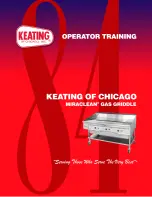
3
C
that’s why it is essential to use a convection tray
and trivet when roasting with these settings. It is
normal for there to be a slight drop in temperature
when you open the lid and put your food in the
barbecue. Don’t worry; the temperature will rise
again over the cooking time. Remember, there
is no need to turn the meat when roasting, so
try not to open the lid unnecessarily. For more
information on roasting and baking on your
Q, have a look at the videos on our website at
www.weberbbq.com.au (Australia)
www.webernz.co.nz (New Zealand)
Roasting tip
Getting the timing right so that your roast
is cooked to your liking can be difficult at
times when cooking outside. Wind, ambient
temperature and the temperature of the meat
when you start cooking all influence the amount
of time a roast needs to be cooked.
One of the best ways to make sure you get
your roast cooked just the way you like it is
to use a meat thermometer. With a standard
meat thermometer you can read the internal
temperature of the meat, so you can tell when
it’s cooked to your liking. An internal meat
temperature cooking chart is included in the
‘Barbecuing and roasting guide’ at the end of this
booklet.
Helpful hints for the Weber Q
Always cook with the lid closed
No matter whether you are cooking a roast,
a barbecue or breakfast on a hotplate,
always cook with the lid closed. Why?
First, cooking with the lid closed creates natural
convection of the air inside the barbecue. This
results in more even cooking with more natural
juices retained.
Second, you will achieve outstanding barbecue
flavour that you can’t get by cooking with the
lid open. This is produced when barbecue smoke
is circulated all around the meat, imparting a
beautiful smokey flavour.
Third, cooking times are greatly reduced (about
half of what you might expect on an open
barbecue), which means you can barbecue the
same amount using a lot less gas. As less gas is
required to cook the food, you don’t need to fill
the gas bottle anywhere near as often (a 9kg gas
bottle will last for over 36 hours of cooking).
Use ‘natural convection’
to get the best results
Remember, these barbecues use natural convection
to cook food perfectly. To assist convection, try not
to cover more than two thirds of the cooking grill
at one time. Whilst they will cook with the whole
cooking surface covered, the results are far better if
you barbecue in two or three batches when feeding
a crowd.
When roasting, make sure the height of your food
fits inside with the lid closed. To allow the air to
circulate properly you should use a convection tray
and Q trivet and make sure you have clearance
between your food and the lid.
How often should you turn the meat?
Your Q™ will produce the most impressive food
when you let the ‘convection process’ do its work
with minimum interruption. For this reason, resist
the temptation to continually turn the food. Each
time you turn the food you have to raise the lid,
allowing the hot air to escape. When barbecuing
meat, outstanding results are achieved if you use
tongs to turn the meat (once only) halfway through
the cooking time. Roasts, on the other hand, should
never need turning.
Food sticking to the grill
When barbecuing food, the meat can sometimes
stick to the hot grill. If the meat is properly branded
(2½ to 3 minutes) before you turn it, it will not stick.
People trying to turn the meat too early often have
this ‘sticking’ problem. Don’t tear it, just leave the
meat where it is and it will come free once properly
branded.
How to get the best from your Weber® Q™

































